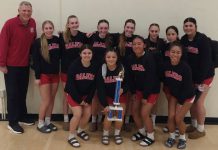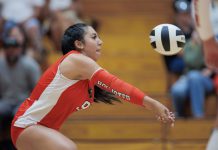Equity league is best option
When Christopher High School opens its doors for business in
September, and slowly but surely begins to siphon students and
athletic talent away from Gilroy High School, no one really has any
clue what exactly will happen to the quality of sports teams at the
two schools.
Equity league is best option
When Christopher High School opens its doors for business in September, and slowly but surely begins to siphon students and athletic talent away from Gilroy High School, no one really has any clue what exactly will happen to the quality of sports teams at the two schools.
It’s expected, based solely on shrinking enrollment numbers, that GHS will lose some of its athletic luster as the 2,484 students that currently attend divide into two different schools.
And chances are, this is exactly what will happen. It’s a numbers game, and those with the most gold, or students-athletes in this case, usually rule.
But with CHS’ plans to operate a sports program as an independent in the first year, and GHS sports perhaps not immediately feeling the affects of a second high school until a few years down the road, the move to place both high schools into the Monterey Bay League beginning in 2010 seems to be a case of too much, too soon at the very least.
In March, 36 schools from the Southern Conference voted in favor of moving the Tri-County Athletic League’s Gilroy High to the MBL, while placing Christopher High into the MBL as well. Other options on the table were a TCAL/MBL equity league, and another option that would have only placed CHS into the MBL, keeping Gilroy in the TCAL.
The vote came as a shock to some.
Those who were shocked had been eyeing an equity league for years, where the MBL and TCAL could team up to form one “super” league with two divisions. The divisions would differ from sport to sport, separating teams based on skill and strength – an English Premiership of sorts located in the South Valley.
Imagine a league where Gilroy, Hollister, Palma, Monterey, Monte Vista Christian and North County battled for baseball supremacy, while in the opposite division, Everett Alvarez, Pajaro Valley, Watsonville and Alisal – with a combined 10-52 overall record – could compete on a more level playing field against one another.
It’d be more exciting, and it may just go a long way in the development of the athletes involved.
But the equity league lost 20-16 on March 9, and Palma High School in Salinas appealed the vote just last week.
Really, with where some schools are right now financially, the equity league is what should have happened all along. Heck, with where GHS is right now competitively, even the third option that would have kept the Mustangs in the TCAL for the time being was a better idea than what won over.
But it’s been said the two Gilroy high schools wanted to compete in the same league – perhaps in order to develop a rivalry, sure to be called the Garlic Bowl – meaning the zero-vote third option was tossed aside. Fair enough.
It is interesting to point out that Gilroy and Christopher, the two schools that are directly affected by the vote, voted for the equity league.
“What the equity league does is it’s a perfect way to bring new schools in,” said GHS Athletic Director Jack Daley following the March 9 vote.
“The equity structure would have let [Christopher High] come in the lower division, and we still would have been in the same league. But now they’ll play in the MBL with us, and that’ll be okay for us. But when schools start to drop sports for financial reasons, with only six or seven schools in a league, then you run the risk of not having enough schools to have a league.”
GHS’ departure would leave the TCAL with just six teams, the minimum amount of teams in order for a league to receive automatic qualifiers. The loss of one more team, which certainly could happen with sports programs struggling during a recession – just look at the East Side Union School District – would mean any postseason berths in that sport could only be awarded through at-large bids, which are difficult enough to receive even under the current standards.
And if it’s an individual sport like wrestling, where at-large bids aren’t even granted, well then it turns into a bit of a nightmare.
Rising transportation costs seem to be of concern for the equity league’s rejection, but this seems to be a rather confusing point. The MBL’s Monterey High and the TCAL’s San Benito High played in non-league games this past season in both baseball and boys basketball. Meanwhile, the two northern most schools in question – Gilroy and Christopher – are set to join the MBL, adding to the transportation costs.
Additionally, MBL teams like Monterey and Watsonville currently compete under the TCAL’s umbrella in boys water polo, among other sports, and will probably still need to continue within that supplemental league if the appeal is rejected.
The GHS/CHS move to the MBL could very well work, but right now it seems to be rather farsighted. The current financial state of prep sports isn’t by any means strong at the moment, and reducing leagues to the absolute minimum isn’t going to help.
Scheduling conflicts will happen on both sides, while the quality of sports teams are usually quite cyclical and don’t always reflect the total amount of students enrolled.
Although it would be ridiculous to say an equity league will cure everyone’s ills, having a larger contingent of schools would make a league’s problems more easily absorbed.









